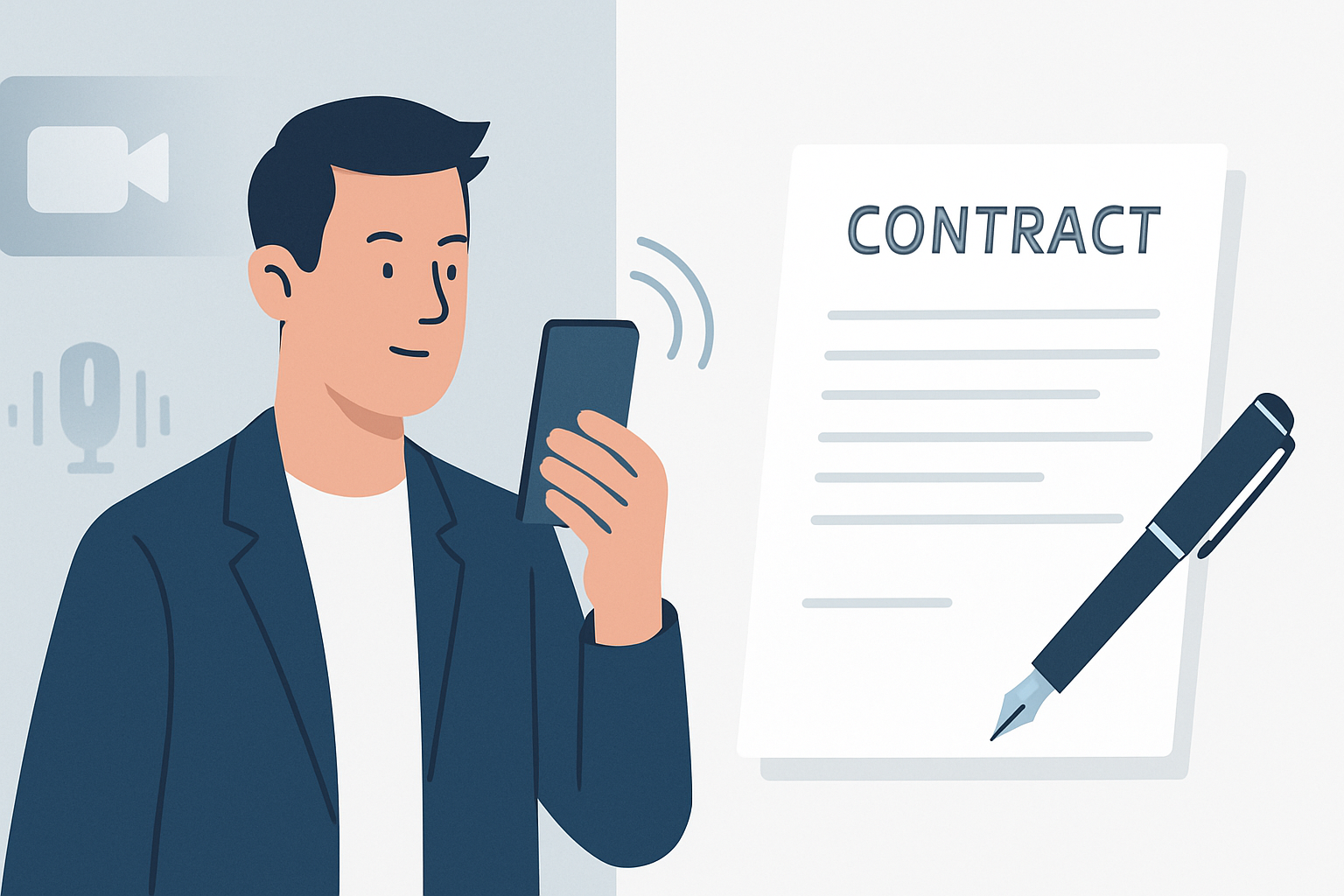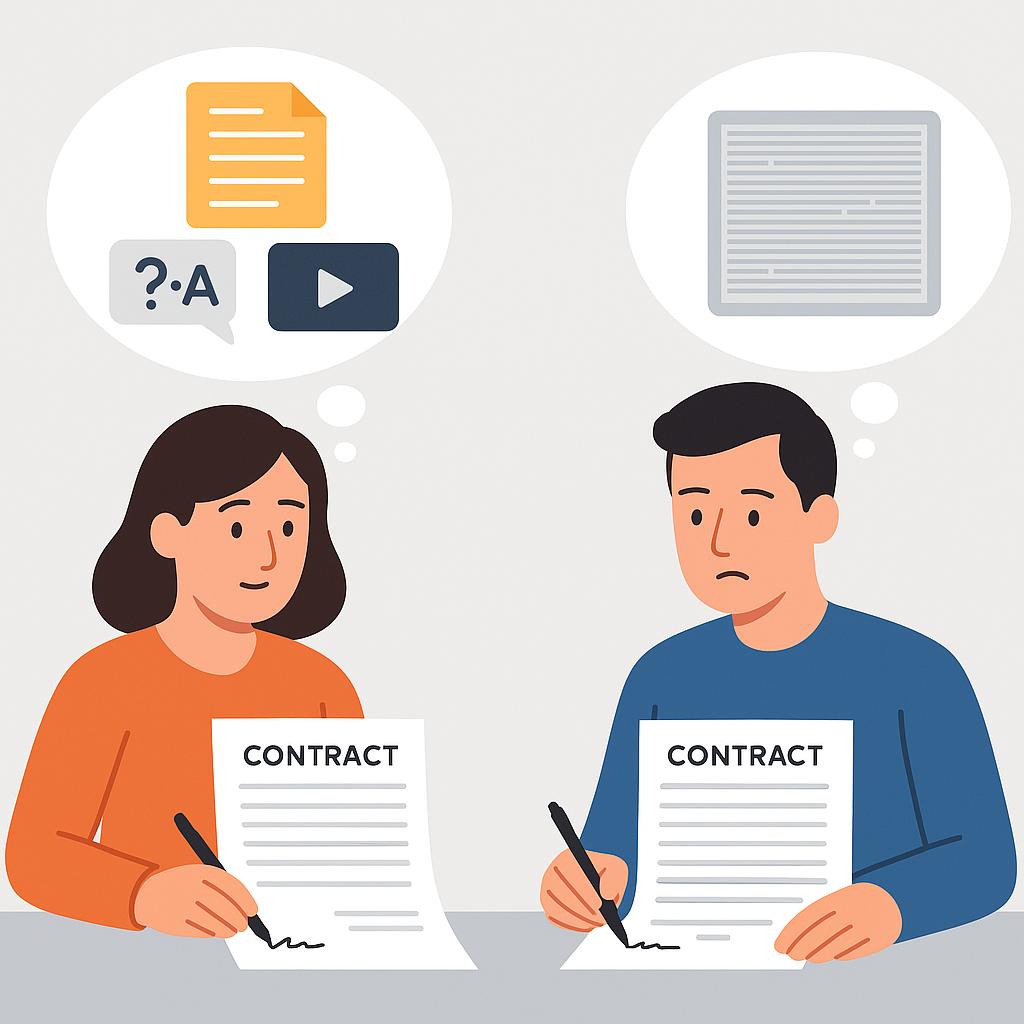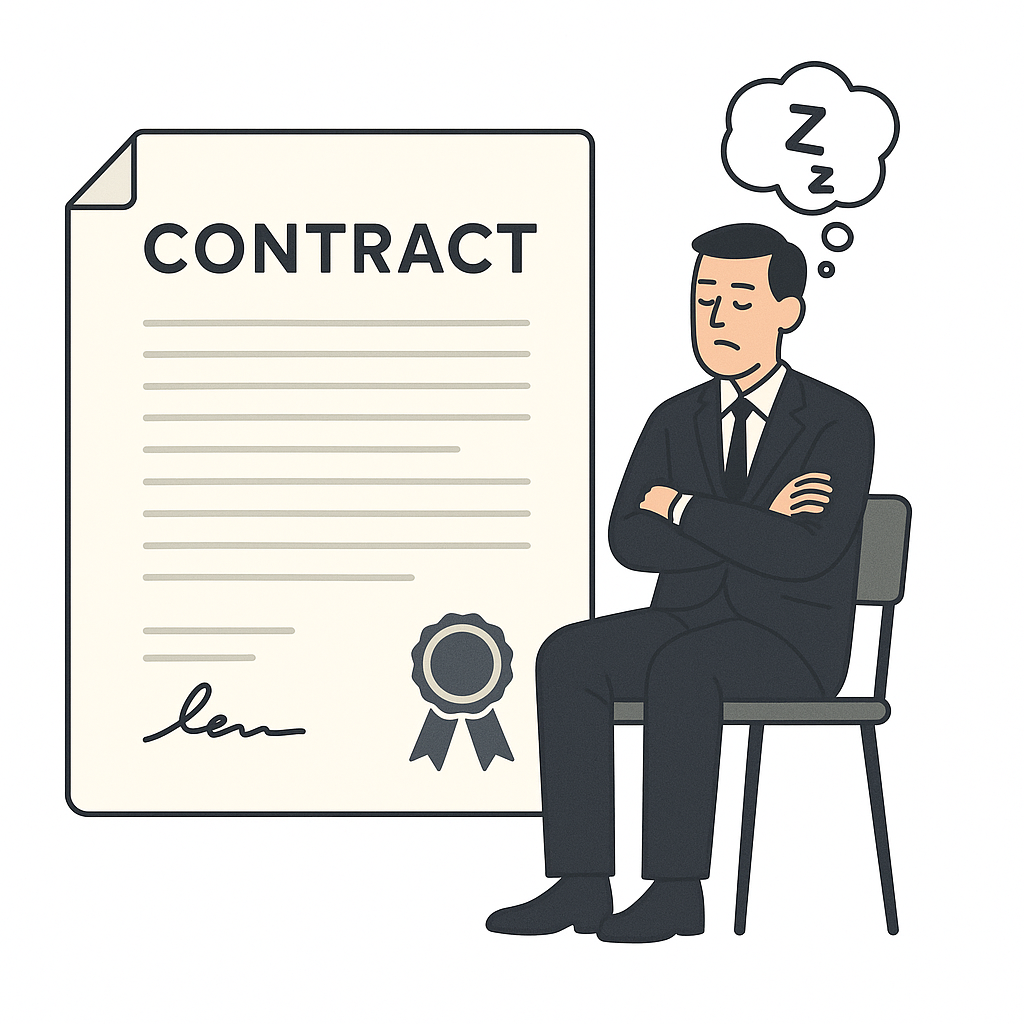Imagine replacing your contract signature with a selfie video of the person saying they understand.
It’s more human and more defensible.
Traditional contract signing has always relied on ink, paper and now digital equivalents like e-signatures. But in today’s world, where communication is shifting to voice notes, video calls and interactive content, it’s natural to ask: Do we really need a “signature” at all?
The short answer is no – not always. Under UK law, many contracts don’t require a signature to be legally binding. What really matters is informed consent. Voice and video consent are quickly becoming powerful alternatives, especially when clarity and proof of understanding are key.
In this blog, we’ll explore:
- What the law says about voice consent in the UK
- Why voice and video consent are more powerful than signatures
- How we interact with information
- Being inclusive is key
- How i agree enables voice and video consent
- When to use voice and video consent
- Why this is the future of agreements
- Key differences: electronic signature vs informed consent
- Final thoughts
What the law says about voice consent in the UK
To understand why voice or video consent is legally valid, it’s important to look at the basics of UK contract law.
A contract in the UK is legally binding when four main elements exist:
- Offer – A clear proposal of terms
- Acceptance – Agreement to those terms
- Consideration – Something of value exchanged (e.g. money for a service)
- Intention – Both parties intend to create a legally binding relationship
A physical signature is not required to prove any of these elements. What matters is evidence of acceptance and understanding. A clear audio recording or video statement where someone confirms they’ve read, understood and agreed to terms can be stronger than a ticked box or scrawled signature.
For example, if a customer records a video saying, “I’ve read these terms and I agree to them”, there’s both verbal confirmation and a time-stamped, identifiable record of their consent.
The UK’s Electronic Communications Act 2000 and various case law examples support the principle that agreements can be made electronically, verbally or even through conduct, as long as it’s clear that both parties agreed.
Why voice and video consent are more powerful than signatures
Signatures don’t prove understanding. They simply show that someone clicked or scribbled at the bottom of a document. In many disputes, businesses find themselves defending claims that customers never really understood what they signed.
Voice and video consent go further. They show that the person heard, saw or spoke the key points. They create an audit trail that is far harder to dispute.
- Human and transparent
Hearing someone say “yes” or seeing them nod on video makes the process feel real and personal. It’s far closer to an in-person conversation where both parties know exactly what they’re agreeing to. - Defensible in disputes
In industries like financial services, law firms or healthcare, it’s common for complaints to arise because people didn’t fully grasp the terms. A video contract or audio signature can show regulators or courts that you went above and beyond to ensure understanding.
(See our blog on clear communication: the key to fewer complaints and disputes for more on this.) - Aligns with modern communication
People now communicate through voice notes, video calls and short-form content more than ever. Asking someone to read a 20-page PDF feels outdated. By switching to voice or video consent, you’re meeting people where they already are.

How we interact with information
The shift to voice and video consent isn’t just a future concept – it reflects how we already engage with content every day. Think about it: we’re constantly using TikTok, Snapchat, Instagram Stories, FaceTime and voice notes to consume and respond to information. People send voice messages instead of long texts. We record selfie videos to explain things more clearly. We join video calls instead of writing long emails.
This isn’t just about convenience – it’s about how we process information. Voice and video are quicker, more human and more natural. Contracts should match that. With voice or video consent, you’re not forcing someone to wade through paragraphs of legal text. You’re giving them the same kind of experience they already have everywhere else – short, clear, and to the point.
Examples of this in everyday life
- Sending a voice note on WhatsApp to explain a decision instead of writing a long message
- Recording a selfie video to give quick project feedback instead of typing an email
- Using Instagram Stories or Snapchat to share updates with visual context and emotion
- Joining a quick FaceTime or Zoom call to confirm details rather than writing a formal document
- Using Loom to explain onboarding steps or product demos in a clearer, more human way
- Giving verbal confirmation on a recorded customer service call for terms or upgrades
- Approving a repair or delivery via a recorded video sent by a technician
- Submitting a TikTok or Instagram Reel as a contest entry — with implied consent and public agreement
Being inclusive is key
Voice and video consent opens the door for people who may struggle with traditional contracts, whether due to low literacy, visual impairments, language barriers or neurodiversity. Instead of asking someone to read through complex legal text, you can explain key terms clearly in plain English using spoken word or visuals. This approach respects different learning styles and helps more people give truly informed consent. By making agreements easier to understand and more accessible, you are not just reducing risk. You are building trust with a wider and more diverse audience.
Read our blog Accessibility is inclusion: One process for everyone to learn more on this subject
How  i agree enables voice and video consent
i agree enables voice and video consent
 i agree is built around one simple idea: make contracts understandable and human. We don’t just digitise paperwork, we replace walls of text with clear summaries, short videos and voice-friendly formats.
i agree is built around one simple idea: make contracts understandable and human. We don’t just digitise paperwork, we replace walls of text with clear summaries, short videos and voice-friendly formats.
Here’s how we make voice consent legal in the UK simple:
- Audio and video agreements
Instead of a static signature, we capture a short video and audio file where the person confirms their understanding of key terms. - Time-stamped evidence
Every voice and video consent is recorded with a secure timestamp and linked to the contract record. - Dynamic contract summaries
Our platform breaks down complex terms into clear, plain-English lines, then plays these back as part of the consent process – much like an interactive briefing. - Regulatory compliance
We ensure all audio signatures and video contracts meet UK legal requirements for proof of consent. For a deeper dive, see our page on legal compliance.
When to use voice and video consent
Voice and video consent isn’t just a novelty. It can be more effective than signatures in situations where clarity is crucial:
- Financial services – Ensure customers truly understand fees, terms or investment risks
- Legal firms – Provide a summary of terms in plain English, then capture video confirmation
- Healthcare and care services – When consent must be informed, a spoken “yes” is stronger proof than a checkbox
- High-value transactions – Where disputes are costly, a video statement can save legal headaches
- SaaS and tech products – For onboarding customers, explaining terms in a short video is far better than sending them dense T&Cs
This isn’t about replacing written terms entirely – it’s about pairing them with a human, accessible way to confirm understanding.
Why this is the future of agreements
Signatures have been the standard for centuries, but the world has changed. Businesses and consumers want clarity, speed and confidence. Voice and video consent provide all three:
- They create richer evidence of agreement
- They show that a business is transparent and client-focused
- They reduce misunderstandings, complaints and disputes
As regulations and technology evolve, it’s likely that video contracts will become standard in sectors where customer protection is key. By using  i agree , you’re already ahead of the curve.
i agree , you’re already ahead of the curve.
Key differences: electronic signature vs informed consent
In our earlier blog, electronic signature vs informed consent: what’s the legal difference, we explored how a signature alone doesn’t always prove understanding. Voice and video consent fills that gap by capturing the moment of understanding, not just the moment of signing.
Final thoughts
Voice and video consent isn’t just a legal workaround – it’s a better experience for your clients. It’s the natural next step in a world where people prefer videos over PDFs and conversations over fine print.
 i agree makes it easy to bring this approach into your business. With audio and video options built in, you can offer a more human, future-proof way for people to say “yes.”
i agree makes it easy to bring this approach into your business. With audio and video options built in, you can offer a more human, future-proof way for people to say “yes.”
Ready to try it?
Explore how  i agree can help you create contracts people actually understand.
i agree can help you create contracts people actually understand.
Check out our FAQ or try our demo to see how it works




